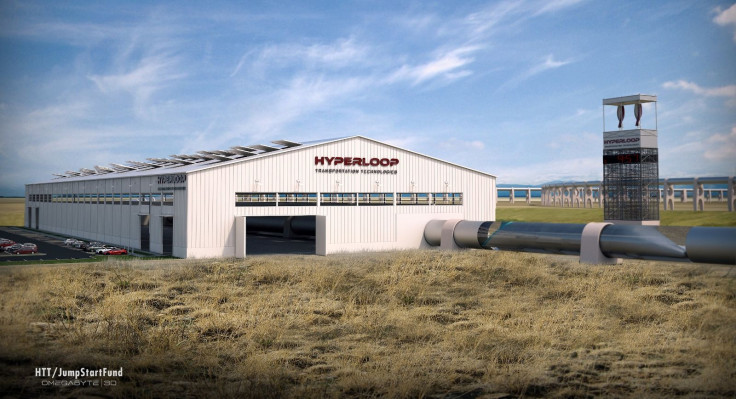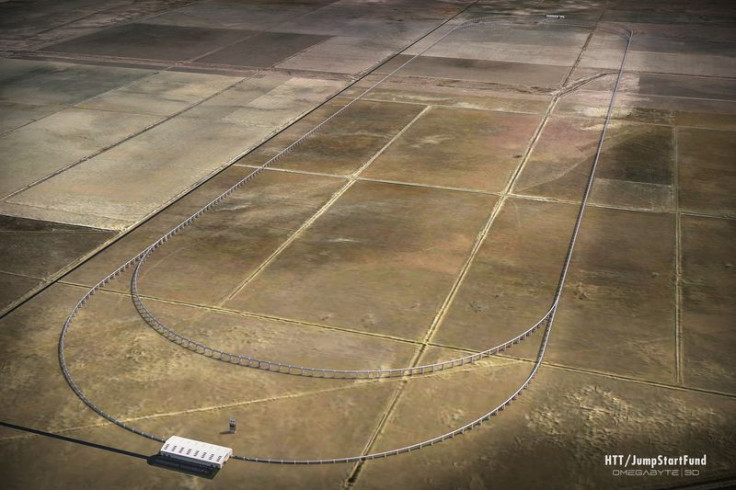Elon Musk's Hyperloop Idea Moves Forward With Test Track Construction, But Don't Book Your Tickets Just Yet

Few took Elon Musk seriously when, back in 2013, the founder of SpaceX and Tesla Motors produced plans to build the Hyperloop, a futuristic high-speed transportation system between Los Angeles and San Francisco. Now SpaceX and another company, Hyperloop Transportation Technologies, are hoping to break ground on separate Hyperloop test tracks by 2016.
Hyperloop Transportation Technologies (HTT), a company created to make Musk's dream a reality, announced last week it has signed agreements to work with Oerlikon Leybold Vacuum and Aecom, a global engineering firm, to begin construction on a full-scale Hyperloop prototype running alongside Interstate 5 through five miles of Quay Valley in the San Joaquin Valley of California. The ultimate goal, Musk has said, is to build an above-ground pressurized train that ferries passengers and cargo between major cities at speeds exceeding 700 miles per hour.
It's too early to predict whether the futuristic mode of transport is even plausible, or guess at how SpaceX and HTT will try to overcome the endless list of obstacles they'll inevitably face. But HTT's new partnership with Oerlikon and Aecom (which is involved with the rail tunnel being constructed beneath the streets of London), publicly traded companies with a responsibility to shareholders, is validation that Musk's blueprints could eventually pay off.
“It’s huge,” said Craig Hodgetts, whose architecture firm Hodgetts & Fung also partnered with HTT as part of the announcement. Hodgetts is a UCLA architecture professor who led the Suprastudio project, which examined the feasibility of the Hyperloop. “ Aecom is an international powerhouse of an engineering firm, and they’re going to bring in a diverse team of specialists looking at life safety issues, propulsion systems and route selection.”

HTT is owned by JumpStartFund, a Southern California-based crowdfunding company that also announced plans to raise at least $100 million as part of an initial public offering by the end of 2015. JumpStarFund CEO Dirk Ahlborn previously predicted the five-mile test track is expected to cost $100 million. How much, if any, money JumpsStartFund has raised for HTT wasn’t immediately clear.
“Once the plausibility of the thing is assured, and it’s at that stage, it then becomes like any other project,” Hodgetts said. “What are the hazards? What do you do if there’s an emergency? How do you actuate some of these devices? Those are the hard questions that are starting to be asked.”
This announcement solves what was the Hyperloop's foremost challenge: being taken seriously. But now developers will need to figure out the details, like actually building the Hyperloop test track and finding the energy to power it.
More than 400 professionals are now working with HTT on the project, according to last week’s announcement. They’re not employees, but engineers and other bright minds who have full-time jobs at SpaceX, NASA, Boeing, Airbus and elsewhere and are moonlighting in exchange for stock options.
The idea of the Hyperloop is to transport people and goods through a pressurized tube that virtually eliminates wind resistance, allowing speeds exceeding 700 mph.
“I don't think the construction hurdles are significant compared to other technologies that are already out there,” Carl Brockmeyer, Oerlikon's head of business development, told Wired magazine, adding “you will be surprised” at how little energy is required. Brockmeyer, whose company previously worked on CERN’s Large Hadron Collider, suggested that the track will run on solar power generated by the solar panels in the Quay Valley. The test track is scheduled to be completed by 2019.
After that, the problems get complicated fast. There are few specifics on the Hyperloop -- where the funding is going to come from or if the project will even get legislative support -- but local transportation experts cautioned that HTT's involvement doesn't guarantee a quick trip between California cities. Land acquisition is especially difficult in California, and even the state's High Speed Rail Authority has had trouble finding enough land to build its own proposed railroad.
The first functioning Hyperloop will likely be built outside California, sources said, contrary to Musk’s initial promise of a 30-minute trip between Los Angeles and San Francisco. California public officials have largely kept silent on the Hyperloop, instead bickering over the specifics of the High Speed Rail system.
“It's just going to be a nightmare for a developer to put together all that land for a transportation development,” said Lisa Schweitzer, a sustainable transportation expert and a professor at the University of Southern California’s Price School of Public Policy. “The best you can do is try to buy people out. Then once you get the approvals in place, which is the longest part for most developers, the amount of time just depends on where you are. It depends how much they're willing to negotiate.”
© Copyright IBTimes 2024. All rights reserved.





















